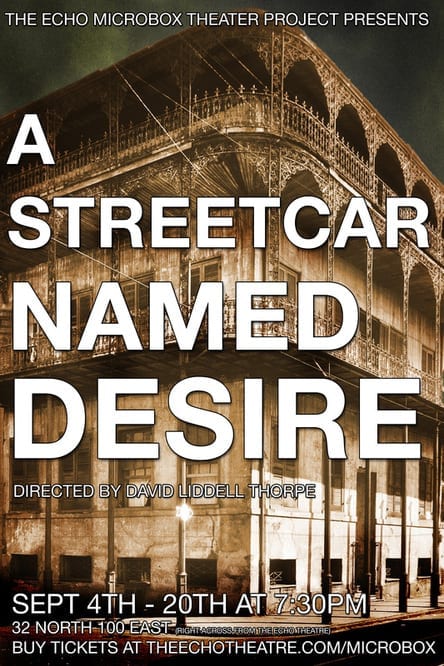
I’ll admit to being apprehensive before sitting down at A Streetcar Named Desire. I’d heard rumors of police being called on prior performances because of what looked like violence. I’d seen photos of accidentally broken glass as a result of the play. And perhaps I should confess: I’d neither read nor seen Tennessee Williams‘ infamous classic A Streetcar Named Desire before stepping into the annex. Not sure how my high school English teachers let me get away with that one, but there you go.
The production took place in The Echo Theatre‘s annex—a building just across the street from the larger, main theater. The small main room was with packed rows of chairs on either side, facing each other, with various set pieces in the middle and into a back room, partially visible from the seats.
Despite the play’s colorful reputation and the nontraditional performance space, the Echo nailed it. After a bit of a slow start and some time to get used to the characters, I found myself feeling just the right amount of discomfort and rapture at the lives unfolding before me in that tiny space. Oh and out on the street. Did I mention that? Director David Thorpe found intriguing potential in an unlikely theater space like the annex. He staged the action not only in the room where the audience sat, but also in the partially-visible back room and on the sidewalk and street just outside. It truly felt like we were flies on the wall of the Kowalski’s cramped New Orleans home.

Round out the intrusive and confining setting with the heat inside the annex. Pre-show announcements included a description of the setting: the very, very hot New Orleans French Quarter, in 1947. Thus it was only appropriate that we audience members sweat a little (The annex has no AC).
Set and costuming helped define the run-down quarter of New Orleans. Sisters Blanche and Stella came from Southern society, but while Stella embraced the blue-collar and simple lifestyle of her husband, Blanche had held on to her Southern Belle attitude. Stella wore plain, simple dresses. Blanche talked incessantly about her looks and adorned herself in lace and bows, constantly primping. The men wore plain colored work shirts, letting their characters be defined by their shaven (or unshaven) faces, unruly hair, and overall attitudes.

Ali Kinkade gave a passionate performance as Blanche Dubois, the broken debutante. Her unease and volatility was potent from her first interaction with Eunice (played by McKenzie Foster) and only became more intriguing and mysterious as the play progressed. Through the first act I found myself wondering what she’d do or say next. I was enraptured by my inability to fully grasp Blanche’s back story. I wanted answers; I wanted pieces to fall into place. Kinkade beautifully played the charade that is Blanche, though. Her energy and passion never faltered, and the role requires quite a lot of both. Heidi Anderson as Stella and Trevor Christensen as Stanley rounded out the family with equal parts passion and vigor. Anderson played a sweet, loyal Stella; and I was never quite sure who’s side Christensen was on, besides his own.
I’ll admit I wished a few moments were a more real. Some reactions struck me as odd and some monologues felt a little too dramatic, but those moments were few and decreased as the night went on. For the most part the cast seemed to breathe through their characters and found the humanity in the text. I especially loved the moments when other characters would appear just outside the annex, walking by, or screaming at each other just out of sight.

The play was overwhelmingly physical. And with the audience so close, at times we experienced some of the same fears Stella and Blanche did when Stanley lunged at them. Near the end of the play, a few women in front of me jumped and fidgeted continually as Stanley and Blanche fought inches from them. Needless to say, this wasn’t a play you could sleep through.
It’s hinted by Stella repeatedly that her relationship with Stanley is to a large extent a physical one and that his often violent actions were overlooked or tolerated because of that. At times the reason for physicality, whether violent or sexual, was obvious. Other times I wasn’t exactly sure what was happening or why it was happening, such as in the second act when Stanley turns on Blanche or the first time Stanley hits Stella. Perhaps the director intended for some motivations and outcomes to remain vague. Some post-show research told me it is merely suggested that Stanley rapes Blanche; I would have liked for Christensen to have clarified his interpretation of the role in some way.
Bottom line: the Echo Theatre Microbox’s Streetcar was an intriguing and unusual sort of production. You won’t find many plays that get more personal or up close than this. Go see the show for the intimacy of the space and the novelty of watching actors yell at each other in the middle of a Provo street. Then stick around because you’ve fallen for the Dubois sisters and want to hope that somehow some good could come of their situations.
[box type=”shadow”]A Streetcar Named Desire plays Fridays and Saturdays through September 27th at 7:30 PM at The Echo Theatre Microbox (32 N 100 E, Provo). Tickets are $8. For more information, visit theechotheatre.com/streetcar.[/box]

